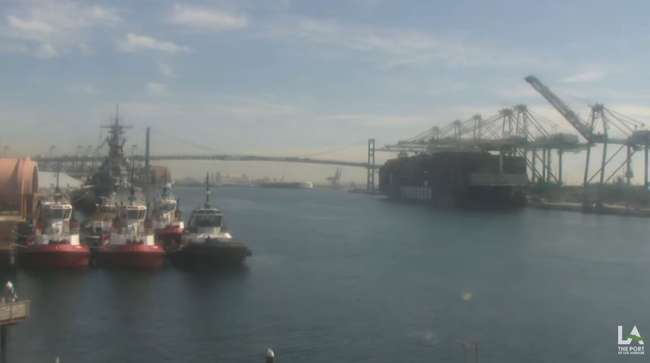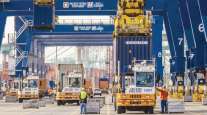Senior Reporter
Ports on Both Coasts Continue Record-Setting Runs in April

[Stay on top of transportation news: Get TTNews in your inbox.]
The nation’s ports reported record container volumes in April as the U.S. economy continues its strong recovery from the COVID-19 pandemic.
Contributing factors are imported goods being rushed to restock stores and warehouses, and consumers continuing their buying spree.
Port of Los Angeles, the nation’s busiest, moved 37% more 20-foot-equivalent containers — 946,966 TEUs compared with 688,999 a year ago.

Seroka
“April continues our record-setting streak for the Port of Los Angeles,” Executive Director Gene Seroka said. “We have set high-water marks six of the last nine months, and the other three months were darn close to new milestones. It’s truly been an unprecedented run here.”
Seroka said this was the busiest April in the port’s 114-year history and the ninth consecutive month of year-over-year increases.
According to port officials, while Los Angeles and adjacent Long Beach are extremely busy, congestion is easing. On May 24, 22 ships were at anchor in San Pedro Bay, down from more than 40 two months ago. The current average anchorage wait time is 5.8 days, down from 7.9 in March.
The Port of Long Beach also saw a nearly 47% surge in TEUs, processing 746,188 compared with 519,730 in 2020.

Colonna
“We are in the midst of our best trade periods in port history, but we cannot forget that the national economy remains in recovery mode,” Long Beach Harbor Commission President Frank Colonna said.
The Port of Oakland notched a 34.3% year-over increase in April, processing 217,993 containers compared with 162,167 the same month a year ago. Some 100,096 of the 217,993 units processed were imports, and it marked the first time that Oakland passed the 100,000-box milestone for imports in a month.
“We’re sounding like a broken record, but containerized trade continues to flourish as the U.S. economy rebounds,” Port Maritime Director Bryan Brandes said. “And as we’ve said before, there doesn’t seem to be a letup in sight.”
Terminal 5 Cranes have started their voyage to Seattle! Traveling on vessel Zhen Hua 36, the cranes have a 30-day voyage before settling in their new home at T5.
SSA Marine, a partner in the T5 project, is the owner + future operator of the ZPMC cranes.https://t.co/DjWe6ByOJw pic.twitter.com/aalf5mY6JD — The Northwest Seaport Alliance (@SeaportNW) May 24, 2021
The Northwest Seaport Alliance, which operates facilities in Seattle; Tacoma, Wash.; Alaska and Hawaii processed 301,074 TEUs, a 21.5% increase from last year’s 247,675.
The Seattle facility is set to take delivery in the next month of four ZPMC super post-Panamax cranes, which are 316 feet tall with a 240-foot outreach boom. The cranes, among the largest on the West Coast, will be able to handle the biggest container vessels operating in the world once Terminal 5 is completed early next year. Along the Gulf of Mexico, Port Houston reported a 25% year-over-year volume increase, processing 275,840 TEUs compared with April 2020’s 221,540. Port Houston in May began the multimillion-dollar project to widen and deepen the busy waterway. The port said it plans to spend $4 billion on infrastructure improvements over the next 20 years,
The story is the same along the East Coast.
The nation’s third busiest port operator, the Port Authority of New York and New Jersey, saw a 3.5% year-over-year increase processing 712,799 containers in April compared with 688,365 the year earlier. A port official told Transport Topics this was the ninth month in a row cargo activity levels set a record.
Later this month, the 1,300 foot long @cmacgm Marco Polo will be making history at our port as the largest vessel to ever hit the east coast. Our 170 foot STS cranes and 4,000 foot berth are ready and able to handle this vessel. To learn more,click the link in our bio. pic.twitter.com/1SboZAeu2E — The Port of Virginia (@PortofVirginia) May 5, 2021
Port of Virginia said it processed 286,405 containers in April, up 38.2% from last year’s 207,244.
The facility also took delivery of 20 new hybrid shuttle trucks and added 500 new chassis to its Hampton Roads Chassis Pool II.
“The strong volumes will be ongoing in May and June, and we are continuing to add new equipment to the operation to meet demand,” Virginia Port Authority CEO Steve Edwards said.
The Delaware Express is worked at #SCPorts Hugh K. Leatherman Terminal as the sun sets. 4 container ships being worked at the Port of Charleston on this beautiful Friday evening. #keepingfreightmoving #chsnews pic.twitter.com/TOfBWjw0rA — South Carolina Ports (@SCPorts) May 22, 2021
Port of Charleston, S.C., set a record for April by moving 225,137 TEUs, a nearly 28% increase over last year’s 176,152. Officials also announced they are expanding inland Port Greer along Interstate 85 between Greenville and Spartanburg. The expansion involves building additional rail processing and storage tracks in the terminal, enlarging the container yard and the existing chassis yard, and building new facilities for heavy-lift maintenance and terminal operations. The expansion was funded, in part, by a $25 million BUILD (Better Utilizing Investments to Leverage Development) grant.
In March, the facility opened Phase 1 of the Hugh Leatherman Terminal, which will further enable the port to handle its growing cargo volume and service ships that carry up to 20,000 TEUs.
JUST ANNOUNCED: Today, the Georgia Ports Authority (GPA) board elected new officers for the coming fiscal year and reported a 38 percent increase in container trade for the month of April. Details: https://t.co/OxetcKmk1l. #gaports #georgia pic.twitter.com/X8qdlHETzs — Georgia Ports (@GaPorts) May 24, 2021
Georgia’s Port of Savannah also had a strong month by processing 466,635 containers. That marked a 38% increase over 337,890 last April. The facility also is expanding, with $305 million in authorized spending for construction on projects that over the next several years will increase Savannah’s annual TEU capacity from 5.4 million to 6.8 million. Other projects underway will increase capacity to where the port can simultaneously handle four 16,000-TEU vessels.
Port of Baltimore said its TEU count in April declined to 85,112 TEUs from 90,036 the previous month. Officials said loaded containers actually were up 8.6% year-over-year, but the number of empty containers processed by workers fell significantly and that was responsible for the decline.
The Port Authority of New York and New Jersey did not have container numbers available at press time.
Want more news? Listen to today's daily briefing below or go here for more info:




